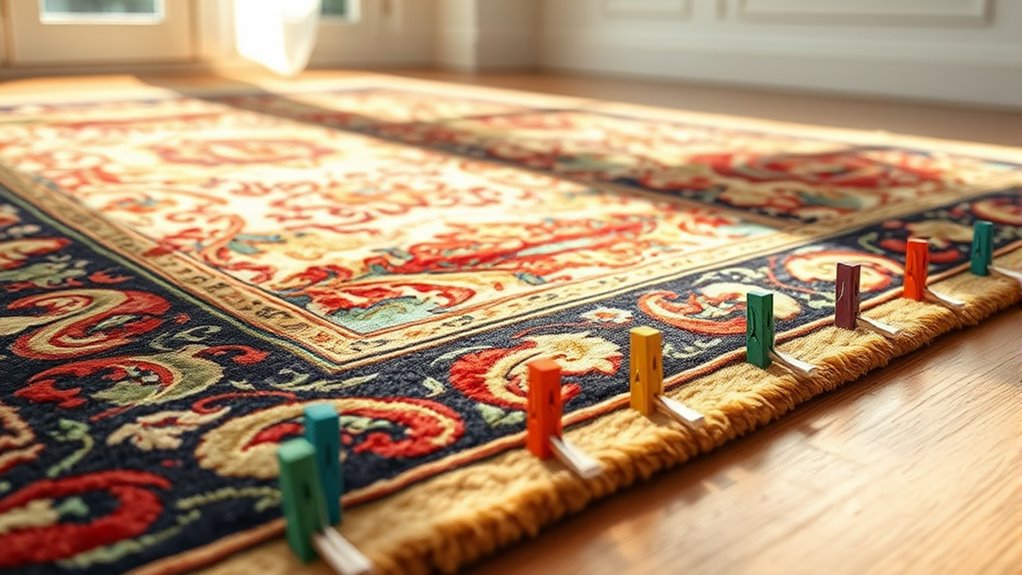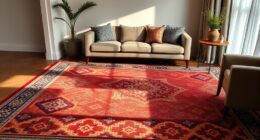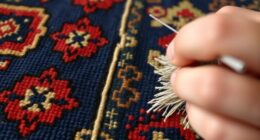After cleaning your rug, blocking and stretching help it stay flat, maintain its shape, and prevent wrinkles or warping. You’ll need tools like pins, stretchers, and a dampening spray. Carefully dampen, stretch, and secure the rug on a flat surface, then let it dry completely to set the shape. Proper techniques and avoiding common mistakes guarantee lasting results. Keep in mind when to seek professional help for best outcomes as you explore this process further.
Key Takeaways
- Gently dampen the rug with water before stretching to prevent fiber damage.
- Secure the edges with pins, weights, or rug clamps to maintain shape during drying.
- Use a flat, padded surface in a well-ventilated area, avoiding direct sunlight.
- Stretch and reshape the rug gradually, ensuring even tension to prevent distortion.
- Allow the rug to fully dry before removing fasteners to set the new shape and prevent wrinkles.
Why Blocking and Stretching Are Important for Your Rugs
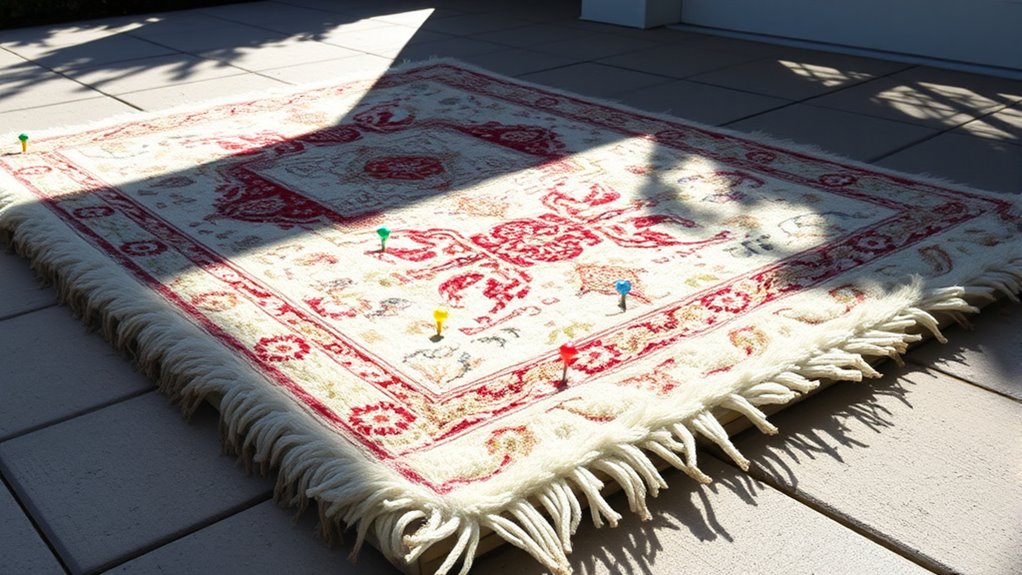
Blocking and stretching are essential steps to guarantee your rugs stay looking their best after cleaning. When you work on an area rug, these techniques help restore shape and prevent future wrinkling. Stretching corrects warps caused by washing or improper storage, ensuring the rug lays flat and even. Blocking emphasizes the rug’s original dimensions, helping to straighten edges and align the fibers properly. Without these steps, your rug may remain warped or misshapen, diminishing its appearance and longevity. Properly stretching and blocking your rug also enhances its overall look, making it look fresh and well-maintained. Whether you’re dealing with a small or large area rug, these techniques are key to maintaining its beauty, ensuring it remains a stunning part of your space.
Tools and Materials Needed for the Process

To successfully block and stretch your rug, you’ll need specific tools and materials. Having the right equipment makes the process easier and safer. Let’s go over what you’ll need, from tools to safety gear, to get started confidently.
Tools for Rug Blocking
Before you begin the rug blocking process, gather the essential tools and materials to guarantee a smooth and effective experience. You’ll need sturdy, adjustable pins or t-pins to secure the rug without damaging the fibers. Use a clean, flat surface like a dedicated rug table or padded area with enough space for your rug to dry and dry flat. Rug padding can help keep the rug stable during stretching. Have a spray bottle filled with water to lightly dampen the rug, which helps prevent color fading and makes stretching easier. Measuring tapes or rulers are useful for ensuring your rug is evenly shaped. Keep a clean towel or cloth handy to wipe away excess water or dirt. Additionally, choosing a location with good ventilation helps the rug dry more efficiently and safely. These tools will help you achieve a properly stretched, well-shaped rug.
Essential Stretching Materials
You’ll need a few key materials to guarantee your rug stretching process goes smoothly. First, gather stretching tools like a rug stretcher or knee-high stretchers, which help evenly pull the rug without damaging fibers. You should also have clean, damp towels to gently moisten the rug, especially if it’s made of delicate fiber types like wool or silk. Tacks or weights can hold the rug in place during stretching, ensuring it maintains the desired shape. Additionally, consider using masking tape or painter’s tape to mark the rug’s edges or patterns, helping you align the rug properly. Keep in mind, different fiber types and rug patterns may require specific handling; knowing these details assure your stretching is effective and safe. For more precise results, understanding the horsepower of electric dirt bikes can help you appreciate the importance of proper maintenance and handling techniques.
Preparation and Safety Gear
Gathering the right tools and safety gear is essential to guarantee a smooth and safe rug stretching process. Proper tool selection and safety precautions help prevent accidents and ensure effective results. Start with these essentials:
- Heavy-duty gloves to protect your hands during stretching and handling
- Knee pads for comfort and safety while working on the floor
- A measuring tape to monitor stretching accuracy
- Rug clamps or stretchers to secure the rug firmly
- Ensuring proper technique and understanding stretching methods improves the overall quality of the job.
Choosing quality tools minimizes risks and makes the process easier. Always wear safety gear to avoid injuries, especially when working with sharp tools or heavy materials. Prioritize safety precautions to prevent accidents, and ensure your workspace is clear to avoid tripping hazards. Proper preparation sets the stage for a successful rug stretching session.
Preparing Your Rug Before Blocking and Stretching
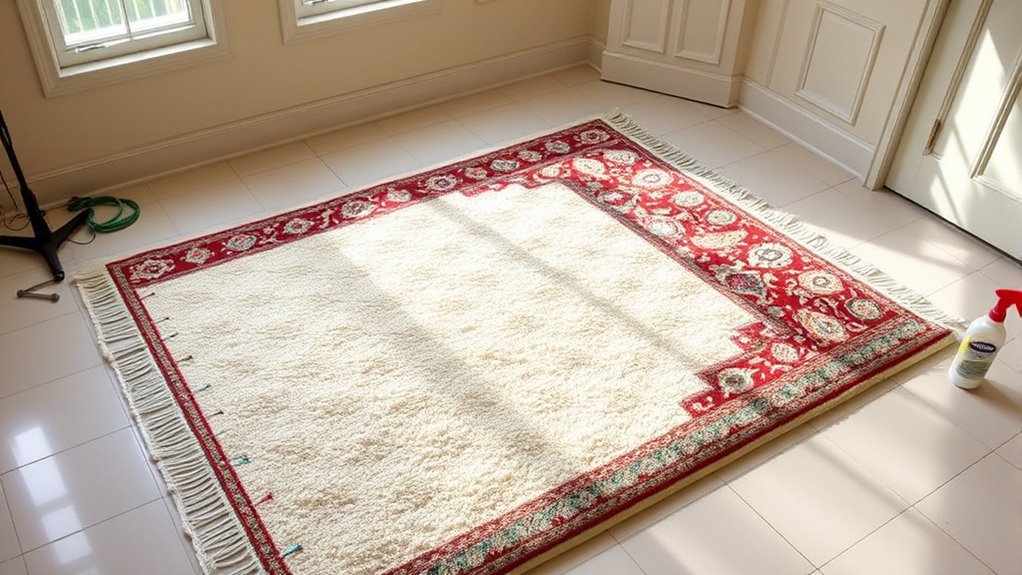
To guarantee your rug responds well to blocking and stretching, start by thoroughly cleaning it to remove dirt, dust, and residues that could hinder the process. Begin with dust removal to ensure no particles interfere with stretching or shaping. Next, measure the rug’s area accurately; knowing its dimensions helps you plan the stretching process effectively. Remove any loose fibers or debris that might cause uneven results. If your rug has stains or spots, treat them before stretching to prevent setting them deeper during the process. Ensuring your rug is clean and measurements are precise will make stretching easier and more effective. Additionally, understanding the benefits of proper preparation can help you achieve the best results when blocking and stretching your rug. Taking these preparatory steps helps your rug achieve a smooth, even finish after blocking and stretching.
Step-by-Step Guide to Blocking Your Rug
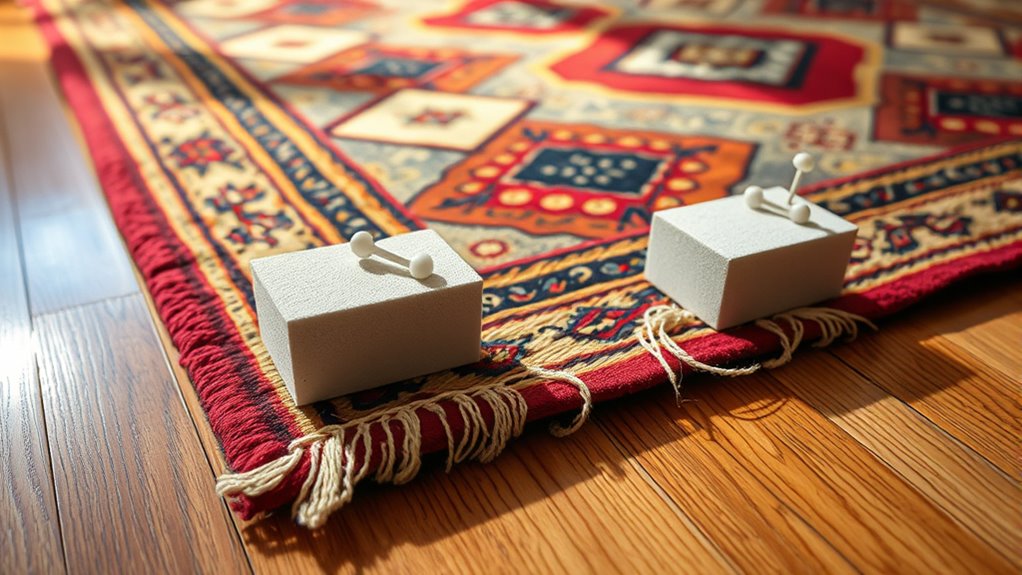
Start by securing your rug in its desired shape on a flat, clean surface. This is essential for effective blocking and rug repair, ensuring your decorative accents stay aligned. Next, follow these steps:
- Gently dampen the rug with water, avoiding excess, to prepare it for shaping.
- Use pins or weighted objects along the edges to stretch and hold the rug in place.
- If needed, reinforce areas with minor rug repair, like frayed edges, before pinning.
- Allow the rug to dry completely, maintaining its shape for a flat, professional finish.
- Regularly inspecting and maintaining your rug helps prevent damage and prolongs its lifespan. Proper maintenance ensures your rug stays in optimal condition over time.
This process helps restore your rug’s original form, enhances its appearance, and guarantees that decorative accents are properly aligned. Proper blocking also prolongs the life of your rug by preventing future damage.
Techniques for Stretching to Achieve a Flat Surface
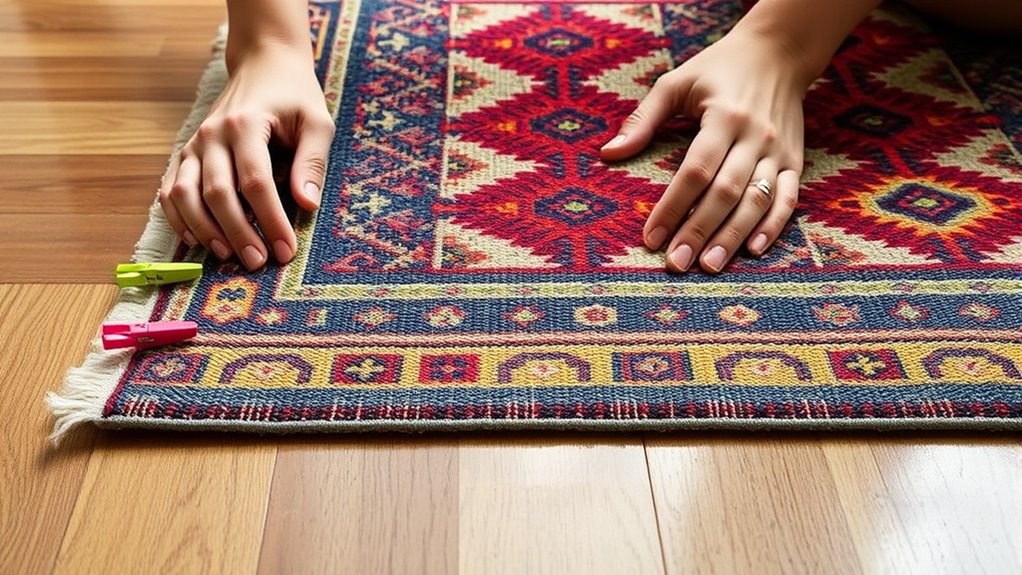
Achieving a flat surface during stretching is essential for a professional-looking finish, and using the right techniques can make this process more effective. To prevent issues like knots and fringes from bunching, ensure the rug is evenly tensioned across all edges. Use a stretching tool or your hands to gently pull the rug outward, focusing on areas where wrinkles or bumps appear. Be cautious of dye bleeding; avoid over-stretching, which can cause color transfer or fiber damage. To maintain uniformity, follow this simple grid:
| Technique | Purpose |
|---|---|
| Gentle, consistent pulling | Prevents knots and fringes from bunching |
| Use of weights or stakes | Keeps the rug flat during drying |
| Check for even tension | Ensures a smooth, flat surface |
Additionally, understanding the importance of spiritual practices like meditation can promote patience and mindfulness during the stretching process, leading to better results. These methods help you stretch effectively while safeguarding rug quality.
Drying and Setting Your Rug After Blocking

Once you’ve finished blocking your rug, proper drying and setting are essential to guarantee it retains its new shape. To assure your area rugs maintain their form, follow these steps:
After blocking, ensure your rug dries thoroughly to preserve its shape and prevent wrinkles.
- Air Dry Carefully: Lay the rug flat in a well-ventilated space, avoiding direct sunlight to prevent fading.
- Use Fans: Turn on fans nearby to speed up moisture evaporation without disturbing the fabric fibers.
- Avoid Hasty Handling: Don’t move or fold the rug until it’s completely dry to prevent wrinkles or distortion.
- Check Regularly: Gently lift the edges to monitor drying progress, ensuring even setting across the rug’s surface.
This careful process helps your rug’s fabric fibers set properly, preserving the shape achieved during blocking.
Tips for Maintaining the Shape and Preventing Future Wrinkles
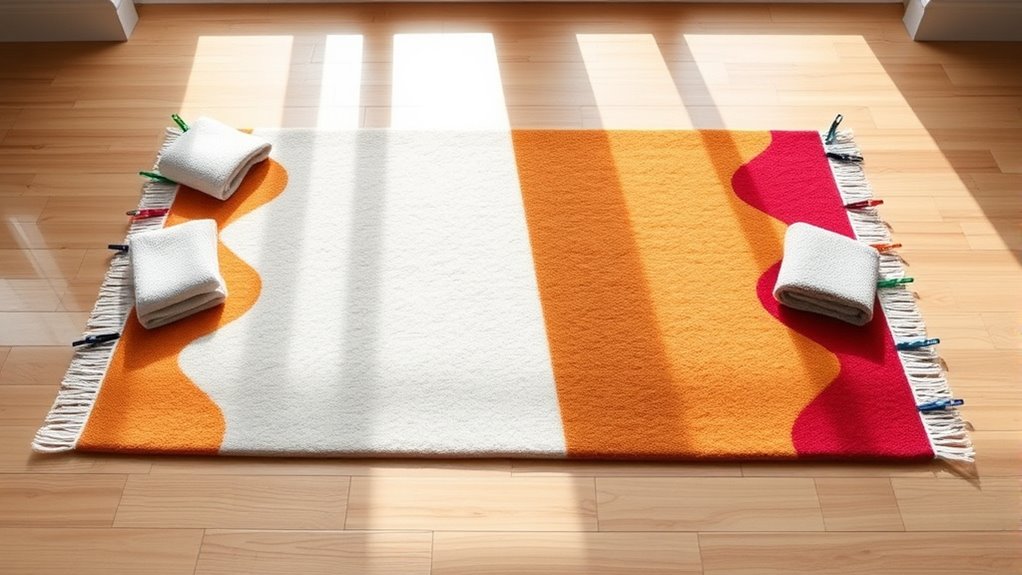
After your rug has dried and set properly, maintaining its shape over time requires ongoing effort. To prevent future wrinkles, consider the rug’s fiber type and dye fastness. Natural fibers like wool and silk are more delicate and need gentle handling, while synthetic fibers such as nylon or polyester are more resilient. Proper placement and regular vacuuming help preserve the shape and prevent uneven wear. Avoid exposing your rug to excessive sunlight, which can fade dyes and weaken fibers. Additionally, understanding the electric bus market can inform decisions about sustainable and durable materials for your home or business. Here’s a quick guide:
| Rug Fiber Type | Care Tips |
|---|---|
| Wool/Silk | Gentle cleaning, avoid direct sunlight |
| Synthetic | Regular vacuuming, minimal sun exposure |
Common Mistakes to Avoid During the Process
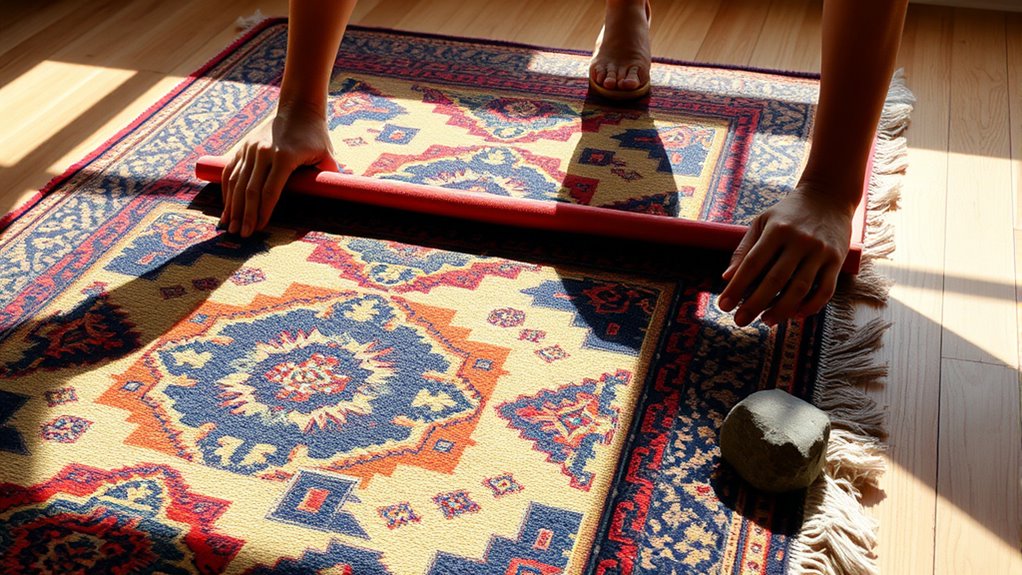
To guarantee your rug stays in great shape, it’s important to avoid common mistakes during blocking and stretching. Mistakes can damage your area rug or compromise fringe repair.
- Overstretching the rug, which can distort its shape and cause uneven wrinkles.
- Using excessive water or harsh chemicals that weaken fibers.
- Failing to secure the edges properly, risking distortion or fraying.
- Neglecting to work gently around delicate areas, especially near fringe repair sections.
- Ignoring the importance of proper drying techniques to ensure the rug retains its shape and durability after stretching.
Be cautious with your technique, especially when handling the edges, to prevent damage. Avoid pulling too hard or unevenly. Properly drying and setting the rug afterward helps maintain its shape. These mistakes can lead to long-term issues, so stay attentive during the process.
When to Seek Professional Help for Rug Stretching

While handling minor stretching or shaping at home can often be effective, some situations call for professional assistance. If your rug shows significant distortion, it’s time to seek a professional assessment. Large ripples, buckling, or uneven stretching indicate that DIY methods may not suffice and could cause further damage. Professionals have the expertise and specialized tools to properly stretch and restore your rug’s shape without risking harm. Additionally, if your rug has experienced extensive wear or damage, a professional can evaluate whether stretching is feasible or if other repairs are needed. Proper maintenance and longevity are crucial for keeping your rug in good condition, and addressing these issues early with expert help guarantees your rug is properly restored and maintains its appearance and value over time.
Frequently Asked Questions
How Often Should I Block and Stretch My Rugs After Cleaning?
You should block and stretch your rugs after cleaning whenever they look warped or uneven, typically every few months or after heavy cleaning. Doing this helps maintain their shape, which extends their rug lifespan. Regular cleaning frequency depends on foot traffic, but aim for every 6 to 12 months. By stretching and blocking as needed, you keep your rugs in good condition, ensuring they stay beautiful and durable longer.
Can I Block and Stretch Synthetic Rugs or Only Natural Fibers?
While natural fiber rugs often benefit from blocking and stretching, synthetic rug considerations differ. You can definitely block and stretch synthetic rugs, but they require gentler handling due to their material. Unlike natural fibers, which are more forgiving, synthetic rugs may need less tension to avoid damage. Knowing these differences helps you maintain the rug’s shape effectively, ensuring it looks fresh and well-kept after cleaning.
Will Blocking and Stretching Damage Delicate or Antique Rugs?
You might worry that blocking and stretching could harm delicate rug concerns or antique rug safety, but if done carefully, it’s generally safe. Use gentle techniques, avoid excessive tension, and work gradually. For antique rugs, consider consulting a professional to prevent damage. Properly executed, stretching can restore shape without risking the integrity of delicate or antique rugs, ensuring they stay beautiful and well-maintained.
How Long Does the Blocking and Stretching Process Typically Take?
Think of the process as guiding a delicate butterfly to its new shape. The time it takes depends on your rug’s size and drying time, usually ranging from a few hours to a day. Larger rugs or those with more moisture need extra patience. By giving it time, you guarantee the rug stretches smoothly without damage, leaving it beautifully restored and ready for its next display.
Is Professional Assistance Necessary for Large or Heavily Wrinkled Rugs?
When dealing with large or heavily wrinkled rugs, you might wonder if you need professional help. While DIY tips can be effective, safety precautions are essential, especially for big projects. If the rug is very large or the wrinkles are stubborn, consider hiring a professional to guarantee proper stretching without damaging the rug. They have the experience and tools to handle challenging situations safely and efficiently.
Conclusion
By carefully blocking and stretching your rug, you’re giving it a fresh start and a chance to regain its best form. With patience and attention, you’ll help it look its best and maintain its beauty for years to come. Remember, sometimes a gentle touch and a little care can reveal hidden strength within. Trust the process, and your rug will quietly thank you by standing tall and proud, ready to grace your space anew.
